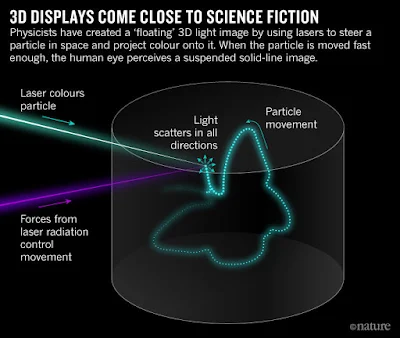Επαναστατική
τεχνολογία τρισδιάστατων κινούμενων εικόνων. This photo provided
by the Dan Smalley Lab at Brigham Young University in January 2018 shows a
projected image of researcher Erich Nygaard in Provo, Utah. Scientists have
figured out how to manipulate tiny nearly unseen specks in the air and use them
to produce images more realistic than most holograms, according to a study
published on Wednesday, Jan. 23, 2018, in the journal Nature. (Dan Smalley Lab, Brigham Young University via AP)
Τρισδιάστατα
κινούμενα έγχρωμα «φαντάσματα» που εμφανίζονται από το πουθενά και κινούνται
στον αέρα και τα οποία είναι καλύτερα από τα ολογράμματα, καθώς συνυπάρχουν αρμονικά
με τα φυσικά αντικείμενα, ενώ είναι ορατά από τους πάντες και από κάθε οπτική
γωνία, δημιούργησαν ερευνητές στις ΗΠΑ.
Δείτε
ένα βίντεο για τις εικόνες... φαντάσματα. A glowing image
resembling a futuristic hologram floats in mid-air. This is a 3D volumetric
display. Using a tiny particle suspended in laser light, researchers have been
able to create high resolution, colour images that take up real 3D space.
Developing this technology could lead to the kind of complex, interactive displays
common in science fiction. Credit: nature video
Το
επίτευγμα χαιρετίστηκε από άλλους επιστήμονες ως «τεχνολογικός θρίαμβος» και
σημαντική πρόοδος, που στρώνει το δρόμο για το «ανακάτεμα» της εικονικής
πραγματικότητας με την φυσική πραγματικότητα στο μέλλον, χωρίς να χρειάζεται να
φορά κανείς ειδικά γυαλιά ή άλλη συσκευή.
Η
νέα πρωτοποριακή τεχνολογία (με την ονομασία "Optical Trap Display") προβάλλει στον αέρα τρισδιάστατα
έγχρωμα γραφικά, τα οποία είναι ορατά από οποιαδήποτε γωνία τα κοιτούν οι
παρατηρητές.
Η
έμπνευση
3D light
projections are ubiquitous in sci-fi films such as the Star Wars series.
Physicists’ latest technology comes the closest yet to mimicking fictional
projections that can be viewed from all directions. Credit: Lucasfilm
Ltd/Kobal/REX/Shutterstock
Τα
«φαντάσματα» αυτά, που δείχνουν πιο πραγματικά από τα συνήθη ολογράμματα,
παραπέμπουν σε εκείνα που παρουσιάσθηκαν στον «Πόλεμο των Άστρων», με πιο
χαρακτηριστική περίπτωση την τρισδιάστατη προβολή στο χώρο της πριγκίπισσας
Λέια με τη βοήθεια του ανδροειδούς ρομπότ R2D2.
Professor Daniel
Smalley and students. Credit: Nate Edwards, BYU Photo
Οι
ερευνητές του Πανεπιστημίου Μπρίγκαμ Γιανγκ της Γιούτα, με επικεφαλής τον
φυσικό Ντάνιελ Σμόλι, που έκαναν τη σχετική δημοσίευση στην επιθεώρηση «Nature»
ανέφεραν ότι η τεχνική τους θυμίζει την τρισδιάστατη εκτύπωση, μόνο που γίνεται
στον... αέρα.
This photo provided
by the Dan Smalley Lab at Brigham Young University in January 2018 shows a
projected three-dimensional triangular prism in Provo, Utah. A study on this
volumetric display was published in the journal Nature on Wednesday, Jan. 23, 2018. By shining light on specks in
the air and then having the particles beam light back out, study lead author
Smalley said the new technology is like "you really are printing something
in space, just erasing it very quickly." (Dan Smalley Lab, Brigham Young
University via AP)
«Η καινοτομία μας είναι ότι δημιουργήσαμε μια
πλατφόρμα τρισδιάστατης προβολής, που είναι ικανή να δημιουργεί εικόνες της
επιστημονικής φαντασίας» δήλωσε ο Σμόλι.
This photo provided
by the Dan Smalley Lab at Brigham Young University in January 2018 shows a
projected image of the earth above a finger tip in Provo, Utah. Scientists have
figured out how to manipulate tiny nearly unseen specks in the air and use them
to produce images more realistic than most holograms, according to a study
published on Wednesday, Jan. 23, 2018, in the journal Nature. (Dan Smalley Lab, Brigham Young University via AP)
Η
τεχνολογία βρίσκεται ακόμη υπό ανάπτυξη και δεν είναι έτοιμη για πρακτική
εφαρμογή σε ευρεία κλίμακα, αν και θεωρείται θέμα χρόνου να συμβεί κάτι τέτοιο.
Μέχρι στιγμής οι τρισδιάστατες εικόνες που δημιουργεί, έχουν ανάλυση έως 1.600 dpi. Άλλες σχετικές τεχνολογίες όπως η
στερεοσκοπία και η ολογραφία, θεωρούνται κατώτερες, καθώς, μεταξύ άλλων,
μειονεκτημάτων, δημιουργούν αντικείμενα που δεν είναι ορατά από κάθε γωνία
θέασης.
Πηγές: A
photophoretic-trap volumetric display, Nature (2018). nature.com/articles/doi:10.1038/nature25176 - http://www.tovima.gr/science/technology-planet/article/?aid=936810







Δεν υπάρχουν σχόλια:
Δημοσίευση σχολίου